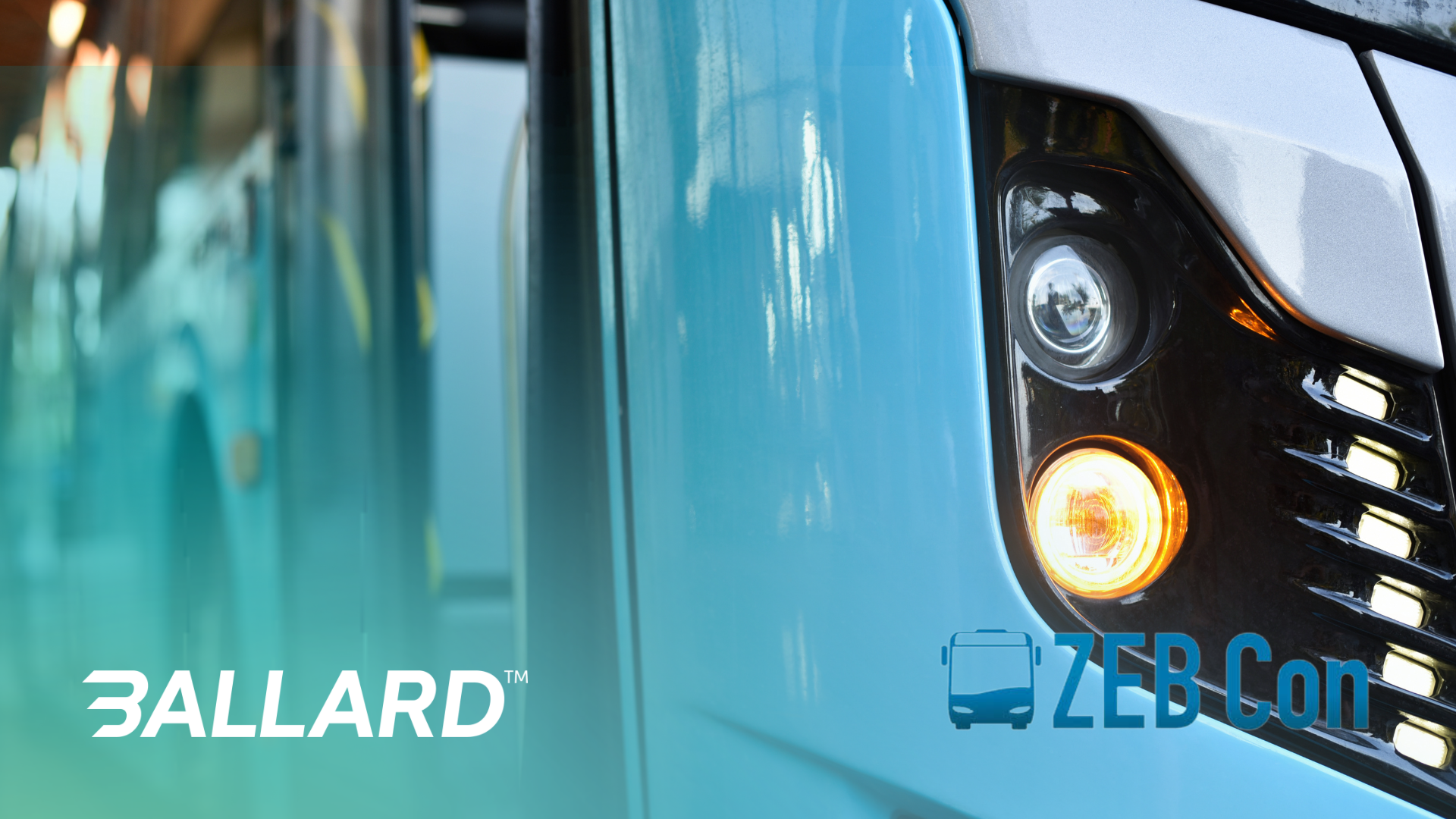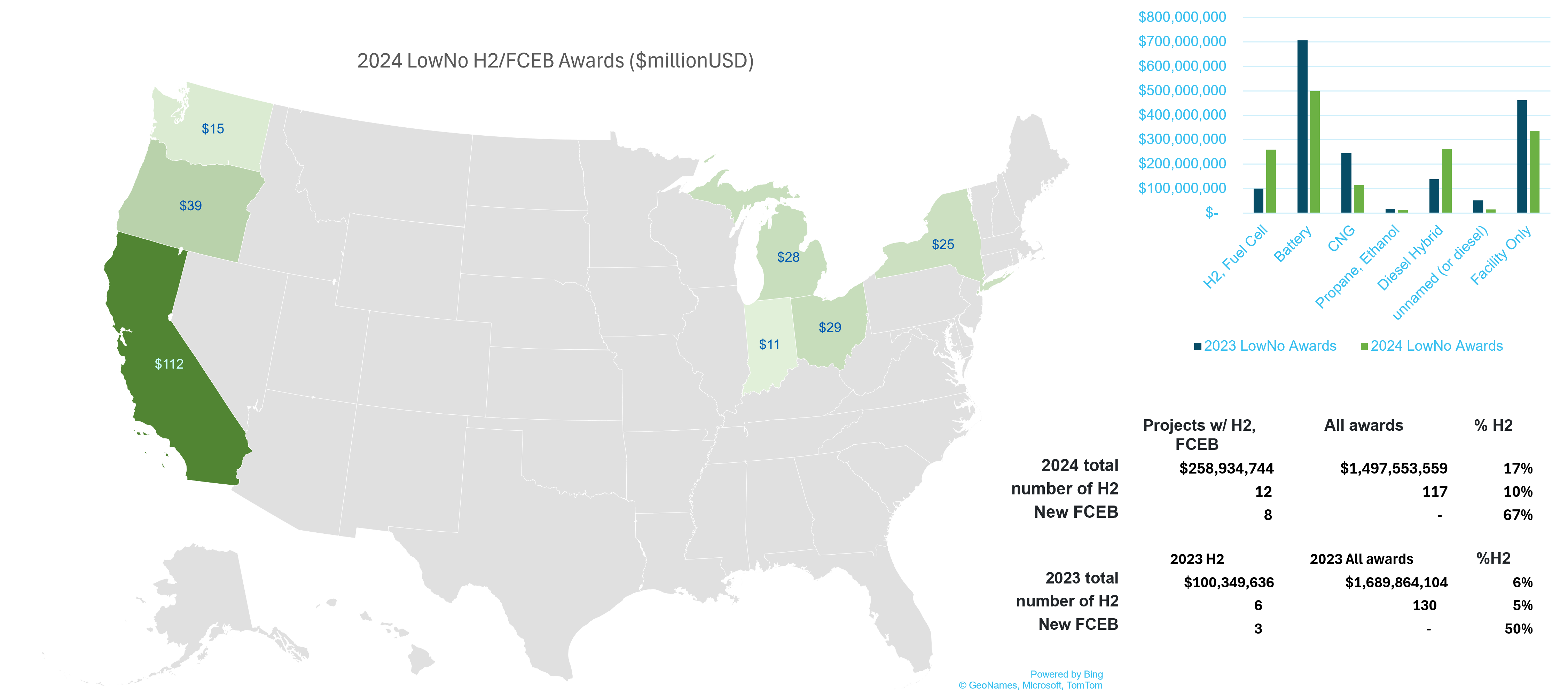
North America is making significant progress in transitioning transit bus fleets to zero-emission (ZEB) alternatives. Recent data indicates a 12% increase in full-size transit ZEB fleets in the U.S., with a remarkable 76% growth in the number of fuel cell buses, which are now operating across 13 states. This upward trend in decarbonization highlights the crucial role hydrogen is playing in driving successful implementation.
Acknowledging this growth in emission-free transport numbers and aiming to harness its full potential to disrupt the landscape for public transit, the U.S. Government’s Federal Transit Administration (FTA) has awarded $1.5bn in bus grants to support nearly 120 projects that will improve public transportation in 47 states. Funding comes from the Low- or No-Emission (LowNo) Program and the Grants for Buses and Bus Facilities (B&BF) Program, which will assist transit agencies in replacing buses powered by legacy fuels, reduce air pollution, improve the reliability of transit systems, and support and up-skill new and existing workforces.
Increasing hydrogen’s influence in public transportation
In 2024, the FTA has prioritized awards that will improve bus manufacturing, stabilize the cost of new vehicles, and accelerate their delivery to transit operators across the U.S., with $390m of the overall LowNo grant figure being awarded specifically for hydrogen-powered transit buses and supplementary facilities.
Of the projects selected 12 were for hydrogen-led initiatives, earning nearly $260m in funded support to help put fuel cell buses on public transport routes in the U.S. California again received the greatest amount of financial backing, with $112m in funding – which is unsurprising given its prolific fuel cell bus deployments and hydrogen infrastructure.
However, highly encouraging inroads have been made outside of California this year, with Oregon ($39m) receiving its first fuel cell bus award, while states with more experience in this area – including Michigan, New York, Ohio and Washington – all added new fuel cell bus transit agencies to their fleets; with awards to Detroit ($15m), Ann Arbor ($12.5m), Syracuse, NY ($7m), Columbus, OH ($11m), and Whidbey Island ($15m).

Further evidence of the growing support for hydrogen in transit in 2024 is shown by the shifting focus of FTA funding across drive technologies. For the first time, LowNo funding for fuel cell projects is above that for natural gas projects. Moreover, hydrogen and fuel cell bus projects received roughly one third of all funding for zero-emission buses, and similar overall financial support as diesel hybrid projects.
Key funded hydrogen projects include the Sacramento Regional Transportation District, which will receive just under $80m to purchase as many as 29 new hydrogen fuel cell buses to replace older buses, modernize facilities and kick-start a workforce development program. The project will also improve service, reliability and air quality throughout the greater Sacramento area in California.
Elsewhere, CityBus in Lafayette, Indiana was awarded over $10m to purchase their first fleet of four fuel cell buses and a fueling station. This complements their 2023 LowNo award of $7m which included funding for the first Ballard fuel cell module in-house training system, to help Lafayette train and develop the bus maintenance technicians of the future.
The FTA’s LowNo initiative, which is now in its fourth of five years of $1bn+ funding, provides critical assistance to companies in the zero-emission mobility space, like Ballard, aiming to deploy hydrogen-powered propulsion technology and refueling stations. This is a burgeoning space that possesses vast potential when it comes to decarbonizing public transport in the U.S.
Enhancing facilities for increased production capacity
Funding like this is crucial for the creation and development of product-focused facilities, such as Ballard’s manufacturing site located in Bend, Oregon, which produces FCmove®-HD+ 100kW fuel cell engines for our North American customers. This is the technology that drives New Flyer’s new Xcelsior CHARGE FC zero-emission transit bus. More than 130 of these increasingly popular buses are deployed or are in delivery in states from California to Pennsylvania, as well as Manitoba and Alberta in Canada.

H2Hubs driving a clean hydrogen network
Hydrogen fuel cell technology presents an exciting route for transit operators to steer towards the full-scale replacement of diesel-powered and internal combustion engine fleets with a zero-emission alternative that can better serve transit agency needs when compared with fossil fuel-powered vehicles. Fuel cell buses even provide advantages compared to battery electric buses – thanks to vital features such as increased range and short fueling time with no compromise on performance.
The Federal Government has recently announced a major effort to reduce or eliminate the primary barrier to fuel cell bus adoption – hydrogen fuel sourcing for fleets. The seven Regional Clean Hydrogen Hubs (H2Hubs) which have been selected for financial assistance will create major increases in clean hydrogen production, leading to rapidly dropping fuel costs, to hit the DoE cost target of $1/kg of clean hydrogen by 2030.
Several hubs such as California’s Alliance for Renewable Clean Hydrogen Energy Systems (ARCHES) hub add vehicle funding to this – providing the financing for 13 transit operators within the state to procure 1,000 fuel cell buses, replacing approximately one third of their present fleets.
In total, the H2Hubs program includes $7bn in funding which will help form the foundation of a national clean hydrogen network that contributes to the decarbonization of crucial sectors of the economy, especially heavy-duty transport. In July 2024, the initiative’s first phase began for a number of hubs, providing planning, design activity for technology deployment and workforce training. These hubs are a critical component of the U.S. Hydrogen Strategy, which is needed to hit national climate goals of a clean electric grid by 2035, and net-zero carbon emissions by 2050.